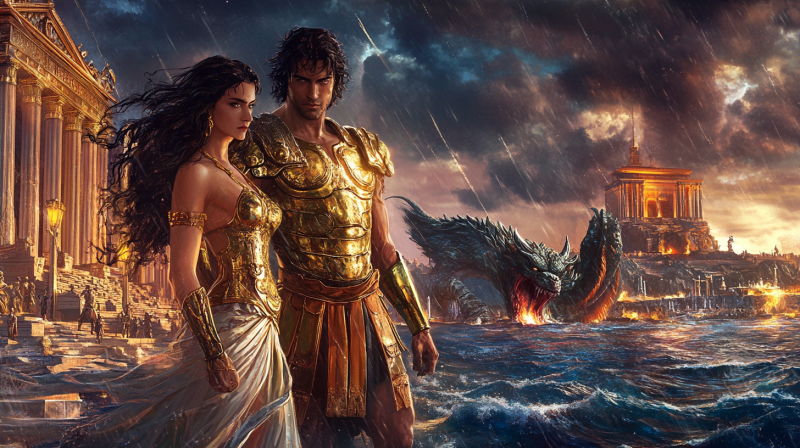The Sumerian civilization, one of the earliest known civilizations, emerged in the southern region of Mesopotamia around 4500 BCE. They were known for their advanced city-states, monumental architecture, and the development of the earliest known writing system, cuneiform. Myths played a crucial role in shaping the beliefs, values, and societal structure of ancient cultures, including the Sumerians. The Sumerian Creation Myth, Enuma Elish, is a significant example of how myths were used to explain the origins of the world and the role of gods in shaping human destiny. This epic tale, written on seven clay tablets, describes the struggle for power among the deities and the creation of the world from chaos. Understanding this provides valuable insight into the religious and cosmological beliefs of the Sumerians and their view of the divine hierarchy.
The Sumerian Pantheon and Context
The Sumerian civilization, which emerged around 4500 BCE in the region of modern-day southern Iraq, had a rich and complex pantheon of gods and goddesses. These deities played a central role in the religious and social life of the Sumerian people, and their myths and legends were passed down through oral tradition and eventually recorded on clay tablets. Among the most important gods in Sumerian mythology were Anu, the god of the heavens and king of the gods; Enki, the god of water, wisdom, and magic; and Enlil, the god of wind, air, and storms. These three deities were central figures in the Sumerian creation myth, which described how the world and humanity were brought into existence through a series of divine actions and conflicts. The Enuma Elish, a Babylonian epic poem that was likely influenced by Sumerian mythology, played a crucial role in Sumerian society, as it was recited during important religious ceremonies and rituals. The epic describes the rise of the god Marduk to supreme power and his role in creating the world and establishing order. The story reflected the Sumerian belief in the importance of divine authority and the role of the gods in shaping the world and human destiny. Overall, the Sumerian gods and goddesses were central to the religious, social, and cultural life of the ancient civilization, and their myths and legends continue to fascinate and inspire people to this day.
Enuma Elish: The Sumerian Creation Myth
The Enuma Elish is a Sumerian creation myth that provides insight into the ancient Mesopotamian understanding of the origins of the world and humanity. The myth begins with the creation of the world through a cosmic battle between the primordial goddess Tiamat and the god Marduk. This epic battle resulted in the formation of the heavens and the earth, as well as the establishment of the natural order. The Enuma Elish also offers a detailed analysis of the cosmological aspects of the world, including the creation of the stars, planets, and other celestial bodies. Furthermore, the myth describes the birth of humanity and their purpose in the world, emphasizing the idea that humans were created to serve the gods and maintain the order of the universe. Overall, the Enuma Elish provides a rich and complex narrative that sheds light on the ancient Sumerian beliefs about the creation of the world and the role of humanity within it.
Summary:
The Sumerian creation myth, also known as The Eridu Genesis, was discovered on a fragmentary tablet in Nippur in 1893. It is written in the Sumerian language and dated to around 1600 BC. Other Sumerian creation myths from the same period include the Barton Cylinder, the Debate between sheep and grain, and the Debate between Winter and Summer, all found at Nippur.
The tablet recounts the creation of the Sumerians by the gods (An, Enlil, Enki, and Ninhursanga) and the establishment of the first cities (Eridu, Bad-tibira, Larak, Sippar, and Shuruppak). It also describes how the gods decide not to save mankind from a flood, and a king learns of this decision. In the later Akkadian version, the god of waters (Ea/Enki) warns a hero (Atrahasis) and instructs him to build an ark, which is missing in the Sumerian fragment but appears to have comparable instructions based on a statement of Enki consulting with himself.
Flood Myth:
Prior to the missing portion, the deities have made the decision to unleash a flood to eradicate humanity. Enki, the god of the underworld sea of fresh water and the equivalent of Babylonian Ea, warns Ziusudra, the ruler of Shuruppak, to construct a large boat, although the specific instructions for the boat have been lost.
Upon the tablet’s continuation, it depicts the flood. A fierce storm rages for seven days and nights. “The enormous boat had been thrown about on the vast waters.” Then Utu (Sun) emerges, and Ziusudra opens a window, prostrates himself, and offers an ox and a sheep as sacrifice.
Following another hiatus, the text resumes with the flood apparently subsided and Ziusudra prostrating himself before An (Sky) and Enlil (Lordbreath), who grant him “eternal breath” for “preserving the animals and the seed of mankind.”. The remainder of the text is lost.
The Epic of Ziusudra introduces an element at lines 258–261 not present in other versions, stating that after the river flood, “king Ziusudra… they caused to dwell in the land of the country of Dilmun, the place where the sun rises.” In this rendition of the tale, Ziusudra’s boat drifts down the Euphrates river into the Persian Gulf (rather than landing on a mountain, or traveling upstream to Kish). The Sumerian word KUR in line 140 of the Gilgamesh flood myth was interpreted to mean “mountain” in Akkadian, although in Sumerian, KUR means “mountain” but also “land”, particularly a foreign country, as well as “the Underworld”.
Parallels:
Other flood stories that share many similarities with the Sumerian tale include the story of the Dravida king Manu in the Matsya Purana, the Utnapishtim episode in the Epic of Gilgamesh, and the Genesis flood narrative in the Bible. Additionally, the ancient Greeks and Romans had two similar myths from a later date: the Deucalion story and Zeus’ world flood in Book I of Ovid’s Metamorphoses. The Germanic and Norse story of Ymir also has similarities to the flood myth.
Symbolism and Themes in the Myth
The exploration of symbolism within Enuma Elish, the Babylonian creation myth, reveals a rich tapestry of allegorical representations that delve into the fundamental themes of order vs. chaos, power, and creation. The mythic narrative portrays the struggle between the forces of order and chaos, personified by the gods Marduk and Tiamat, respectively. Through its vivid imagery and intricate symbolism, Enuma Elish offers a profound reflection on the nature of power and its role in the establishment of cosmic order. Furthermore, the myth provides a compelling examination of the process of creation, shedding light on the origins of the universe and the divine forces that shaped it. When compared with other creation myths from different cultures, such as the Greek, Egyptian, and Hindu traditions, Enuma Elish offers a unique perspective on the fundamental questions of existence and the nature of divinity. By conducting a comparative analysis with these other myths, scholars can gain a deeper understanding of the universal themes and motifs that underpin the human quest to comprehend the origins of the cosmos. In this way, the exploration of symbolism within Enuma Elish not only enriches our understanding of this ancient Babylonian myth but also provides valuable insights into the broader spectrum of creation narratives found across diverse cultural traditions.
Legacy and Influence
The Enuma Elish has had a profound impact on subsequent cultures and religions throughout history. The story, which dates back to ancient Mesopotamia, has left traces in various myths and religious texts from different civilizations. The concept of a divine struggle and the creation of the world through the actions of powerful deities can be seen in later narratives such as the Babylonian creation myth, the Hebrew Bible, and even Greek mythology. The influence of the Enuma Elish can also be observed in the development of religious beliefs and practices, as well as in the formation of societal structures and political systems. Furthermore, the modern-day relevance and significance of ancient creation narratives, including the Sumerian Creation Myth, lie in their ability to provide insight into the human experience and the origins of the universe. These stories continue to shape our understanding of the world and our place within it, offering valuable perspectives on the nature of existence, morality, and the relationship between humanity and the divine. As such, the study of ancient creation narratives remains a crucial aspect of cultural and religious studies, providing a rich tapestry of traditions and beliefs that continue to influence our world today.
Interpreting Enuma Elish Today
In the contemporary scholarly landscape, the interpretation of Enuma Elish holds a significant place, not merely as a relic of ancient Mesopotamian culture but as a text that continues to offer valuable insights into the human condition and the nature of existence. As scholars grapple with the complex themes embedded within this ancient myth, they seek to understand its relevance in today’s context. The enduring appeal of Enuma Elish lies in its ability to transcend time and culture, offering a window into the fundamental human experience. By delving into the depths of this myth, contemporary interpreters aim to shed light on the universal themes it encompasses, including creation, power dynamics, and the eternal struggle between chaos and order. Furthermore, the relevance of understanding ancient myths in today’s context cannot be overstated. In a rapidly changing world where the past is often overshadowed by the present, the study of ancient myths provides a valuable perspective that can guide us in navigating the complexities of modern society. Enuma Elish, with its rich tapestry of symbolism and allegory, offers a treasure trove of lessons and insights that can be drawn upon to address contemporary challenges. Its portrayal of the cosmic struggle for supremacy and the delicate balance between creation and destruction serves as a poignant reminder of the enduring human quest for meaning and stability. By examining the text through a modern lens, we can uncover valuable lessons that resonate with our current societal, ethical, and existential dilemmas. Enuma Elish, therefore, stands as a timeless repository of wisdom, offering a profound understanding of the human experience that continues to reverberate in the fabric of modern society.
The Enuma Elish, the Sumerian Creation Myth, holds significant importance in Sumerian culture as it not only serves as a creation story but also as a means of understanding the Sumerian worldview and their beliefs about the origins of the universe. The myth provides insight into the Sumerian understanding of the relationship between gods and humans, the nature of power and authority, and the importance of order and chaos in the world. Studying ancient myths such as the Enuma Elish is essential for gaining a deeper understanding of the cultural, religious, and societal values of ancient civilizations. By examining these myths, we can gain valuable insights into the ways in which ancient societies perceived the world around them and how they sought to make sense of their existence. Furthermore, the study of ancient myths allows for a greater appreciation of the diversity of human thought and belief systems throughout history, fostering a more comprehensive understanding of the human experience. The enduring legacy and relevance of the Sumerian Creation Myth lies in its ability to provide a window into the beliefs and values of one of the world’s earliest civilizations. By continuing to study and analyze this myth, we can gain a better understanding of the cultural and religious practices of the Sumerians, and in turn, gain a greater appreciation for the rich tapestry of human history and the ways in which ancient myths continue to shape our understanding of the world.





